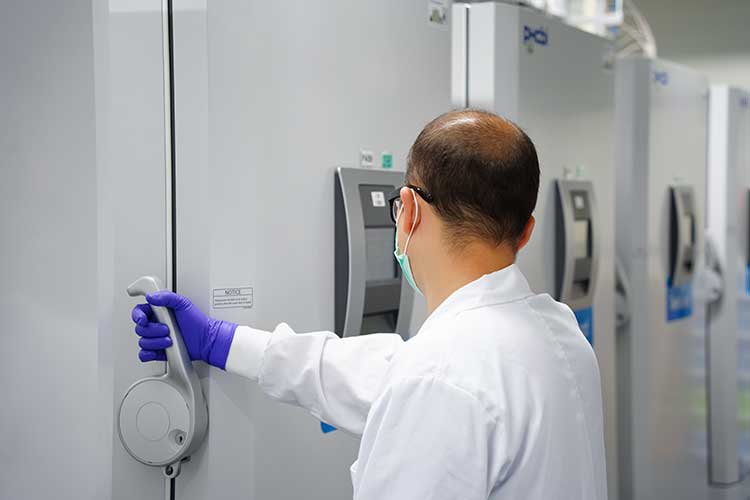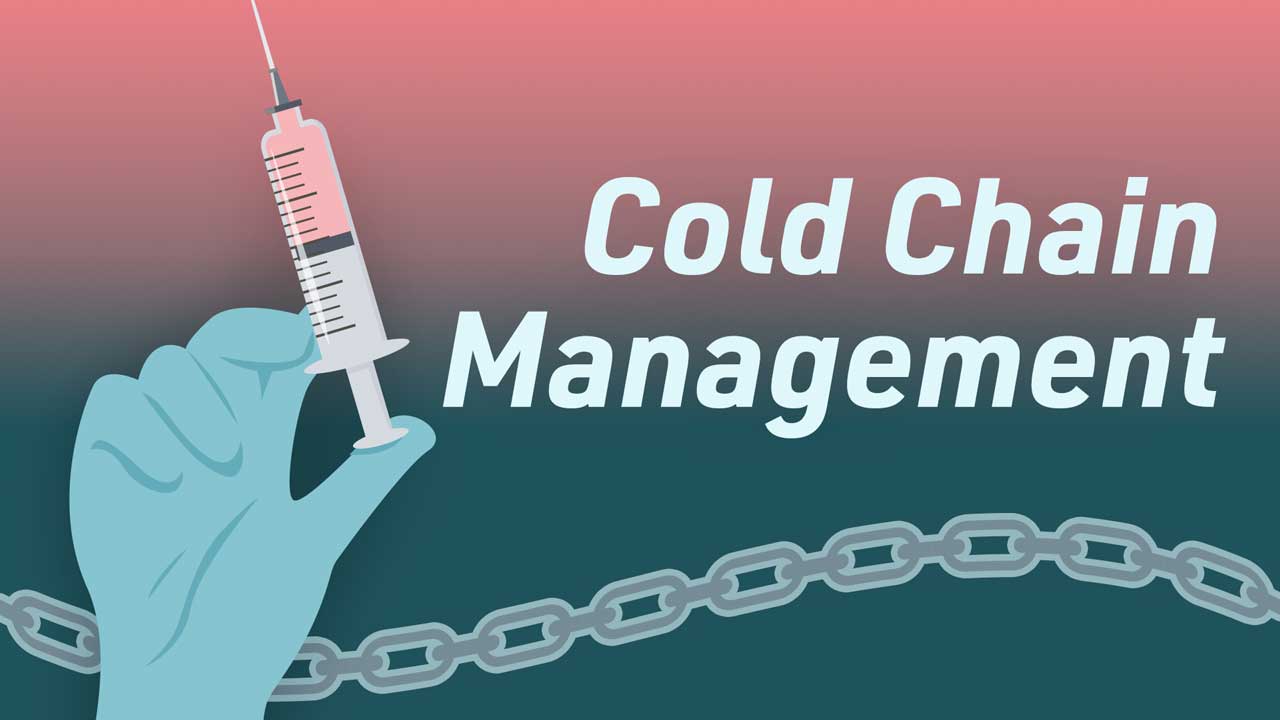Vaccines are fragile biological substances that are at risk of losing efficacy or being destroyed if stored incorrectly. Cold chain management aims to protect vaccines from being spoiled by ensuring they are kept at an appropriate temperature (DoH 2019).
What is a Cold Chain?
The term ‘cold chain’ refers to the process of storing and transporting vaccines between the temperature range of +2°C and +8°C. This temperature must be maintained from manufacturing up until administration in order to ensure vaccine efficacy (Australian Immunisation Handbook 2021).
While vaccines vary in stability and sensitivity, optimal storage temperature is +5°C, which is in the middle of the safe temperature range (DoH 2019).
Why is Cold Chain Management Important?
Vaccines can become spoiled if they are:
- Frozen
- Too warm
- Exposed to direct sunlight or ultraviolet (UV) light (including fluorescent light).
(WA Department of Health 2023a)
The effects of exposure to heat, freezing, and light are cumulative and cannot be reversed (DoH 2019).
Once spoiled, vaccines lose potency and are unsuitable for use on patients. They may:
- Fail to properly protect patients against disease
- Cause negative side effects.
(CESPHN 2020)
Other negative outcomes of a spoiled vaccine include:
- Patients needing to be revaccinated, which is inconvenient and costly
- Loss of credibility for the healthcare provider that administered the spoiled vaccine
- The potential for legal action to be taken against the healthcare provider that administered the spoiled vaccine
- Waste of vaccines.
(CESPHN 2020)
Cold Chain Management Requirements

The National Vaccine Storage Guidelines outline national requirements for maintaining the cold chain.
Equipment
- Purpose-built vaccine refrigerators must be used for all vaccine storage.
- A refrigerator with a freezer should be used to store ice packs and gel packs.
- Vaccine temperature-monitoring devices must be used to monitor the cold chain. At a minimum, a vaccine refrigerator should have a basic data logger and thermometer. Other temperature-monitoring devices include:
- Temperature chart recording systems, data loggers
- Disposable cold chain monitors
- Automated temperature-monitoring systems
- Back-to-base systems.
(DoH 2019; WA Department of Health 2023a)
Vaccine Monitoring
- Vaccine refrigerators must be monitored twice daily for current, minimum, and maximum temperatures
- Data logger information should be downloaded and reviewed weekly
- Thermometers should be checked annually, after changing the batteries, and if there are cold chain issues. This check should be performed using a ‘slush test’.
(DoH 2019; WA Department of Health 2023a)
Cold Chain Management Training
As a general requirement, healthcare providers should ensure that all staff involved in transporting, storing, and administering vaccines have been trained in vaccine management to ensure that the potency and effectiveness of vaccines are maintained (DoH 2019).
Some states and territories have specific cold chain management training requirements for staff:
- New South Wales: At least one staff member per organization must complete the NSW Health Vaccine Storage and Cold Chain Management online learning module - however, it’s recommended that all employees complete this training.
- Victoria: As of 2023, all government vaccine account holders must designate a Vaccine Coordinator and backup person to undertake the Victoria Department of Health’s Clinical/Vaccine Coordinator Cold Chain Management eLearning module and upload a certificate of completion. Other staff members who are involved in cold chain management are encouraged to undertake the Cold Chain Management eLearning module relevant to their job role.
- Western Australia: immunisation providers should refer to the Educational Requirements for Immunisation Provision table and complete all required education for their job role.
(Health.vic 2023; NSW Health 2020; WA Department of Health 2023b)
Cold Chain Breaches
What is a Cold Chain Breach?
A cold chain breach occurs when a vaccine goes outside of the recommended temperature range (DoH 2019).
All cold chain breaches must be reported to the designated body for the state or territory in which the breach occurred. The only exception that does not need to be reported is if a vaccine reaches a maximum of +12°C for 15 minutes or less (DoH 2019).
Note: As of August 2023, Victorian providers must report all cold chain breaches for government-funded vaccines, except for fluctuations of up to +12°C for 15 minutes or less when restocking, cleaning the fridge or stock-taking (Health.vic 2023). Previously, Victorian providers were exempt from reporting first-time breaches if the breach was under 25°C for less than six hours (Health.vic 2022). However, this exemption no longer applies.
Responding to a Cold Chain Breach
If a cold chain breach occurs, the following steps must be taken:
- Isolate the affected vaccines immediately.
- Label the affected vaccines ‘do not use’ and keep them refrigerated between +2°C and +8°C. They may need to be moved to temporary monitored vaccine storage.
- Report the breach to the relevant state or territory health department as soon as possible. There may be a particular form that needs to be completed.
- Only dispose of the affected vaccines if advised to do so by the health department. If vaccines are discarded, ensure medical waste procedures are followed.
- Take steps to correct the issue and prevent a breach from recurring.
- If the affected vaccines were privately purchased, contact the manufacturer for guidance.
(DoH 2019; WA Department of Health 2023a)
When reporting a cold chain breach, the following information may need to be provided:
- Vaccine products and dose quantities
- Whether the affected vaccines have been involved in a prior breach
- Date on which the breach occurred
- Length of the breach
- Whether the affected vaccines were administered to patients
- Temperature range of the breach
- Data logger results
- Staff contact details.
(WA Department of Health 2023a; CESPHN 2023)
Test Your Knowledge
Question 1 of 3
What is the optimal storage temperature is for vaccines?
Topics
References
- Australian Immunisation Handbook 2021, Glossary of Technical Terms, Australian Government, viewed 14 December 2023, https://immunisationhandbook.health.gov.au/technical-terms
- Central and Eastern Sydney PHN Immunisation Program 2020, Cold Chain Breach, CESPHN, viewed 14 December 2023, https://cesphn.org.au/wp-content/uploads/2022/09/20190522-CESPHN-Why-report-a-cold-chain-breach.pdf
- Central and Eastern Sydney PHN Immunisation Program 2023, Cold Chain Management, CESPHN, viewed 14 December 2023, https://cesphn.org.au/general-practice/practice-support-and-development/immunisation-gp/immunisation-cold-chain
- Department of Health 2019, National Vaccine Storage Guidelines ‘Strive For 5’, 3rd edn, Australian Government, viewed 14 December 2023, https://www.health.gov.au/resources/collections/national-vaccine-storage-guidelines-resource-collection
- Health.vic 2022, Cold Chain Breach Reporting, Victoria State Government, viewed 18 December 2023, https://web.archive.org/web/20220316042821/https://www.health.vic.gov.au/immunisation/cold-chain-breach-reporting
- Health.vic 2023, Cold Chain Management, Victoria State Government, viewed 18 December 2023, https://www.health.vic.gov.au/immunisation/cold-chain-management
- NSW Health 2020, National Vaccine Storage Guidelines 'Strive for 5' (3rd Edition) 2019, New South Wales Government, viewed 18 December 2023, https://www.health.nsw.gov.au/immunisation/Pages/strive-for-five-changes.aspx
- WA Department of Health 2023a, Cold Chain Management, Government of Western Australia, viewed 14 December 2023, https://www.health.wa.gov.au/articles/a_e/cold-chain-management
- WA Department of Health 2023b, Educational Requirements for Immunisation Provision, Government of Western Australia, viewed 18 December 2023, https://www.health.wa.gov.au/~/media/Corp/Documents/Health-for/Immunisation/Immunisation-education/Immuniser-education-requirements-table.pdf
Additional Resources
- National Vaccine Storage Guidelines ‘Strive For 5’ | DoH
- COVID-19 Vaccine Cold Chain Breach (CCB) Reporting Form | Australian Government
- NSW Health Vaccine Storage and Cold Chain Management Online Training Module | New South Wales Government
- Queensland Health Immunisation Program Course 4: Vaccine Management | Cunningham Centre
- Cold Chain Management Course - Non-clinical Staff | Victoria Department of Health
- Cold Chain Management Course - Clinical Staff/Vaccine Coordinators | Victoria Department of Health
- Educational Requirements for Immunisation Provision | Western Australia Department of Health
 New
New 
